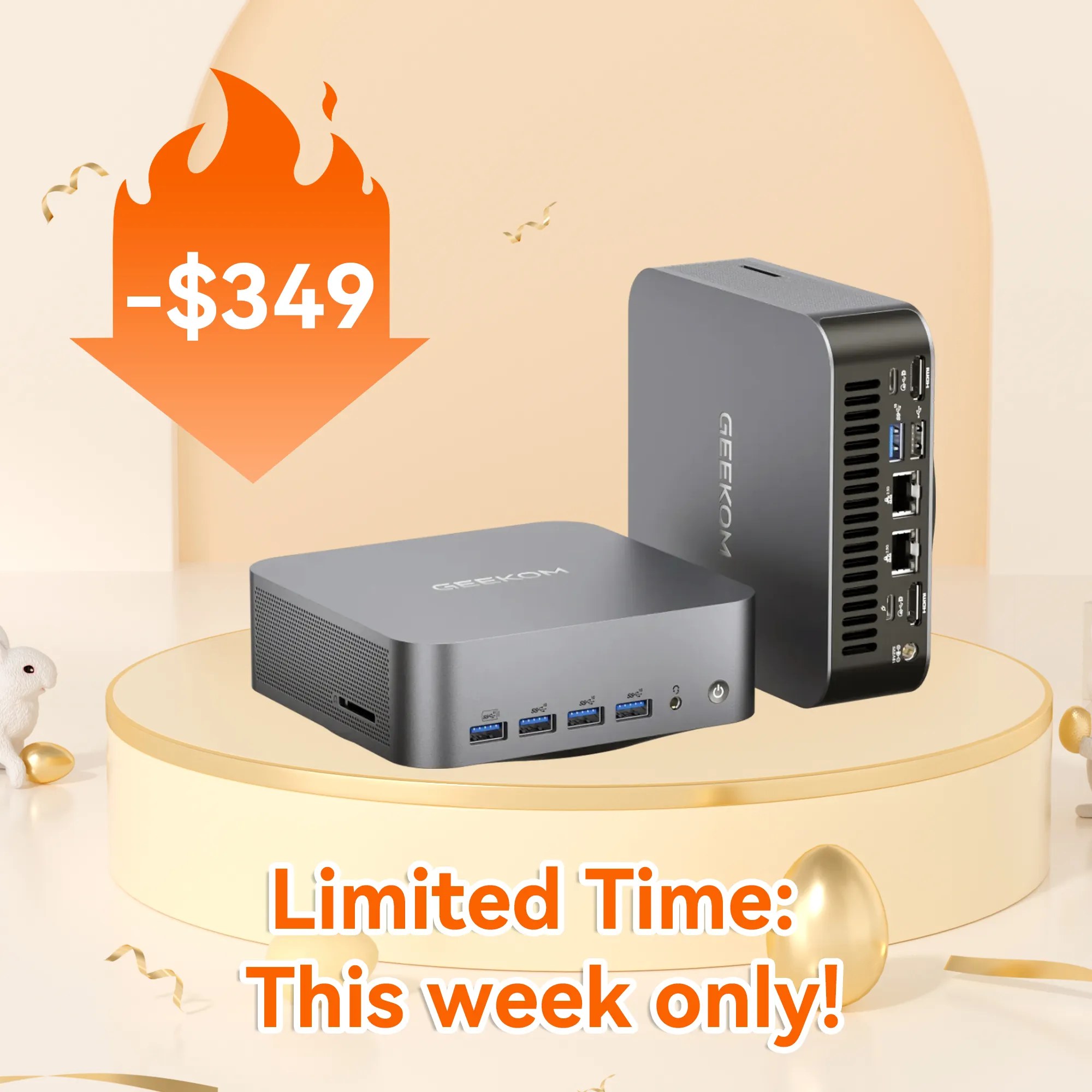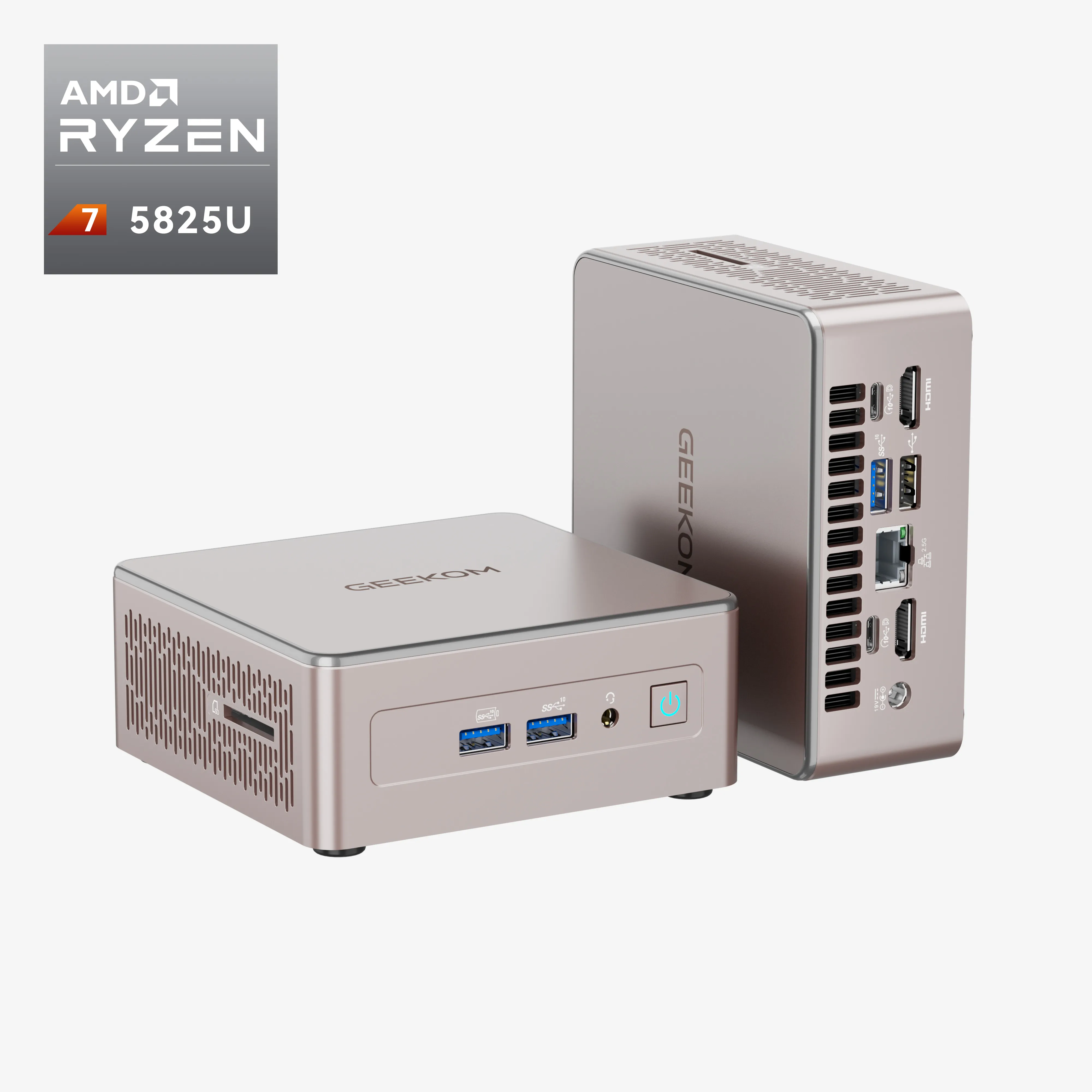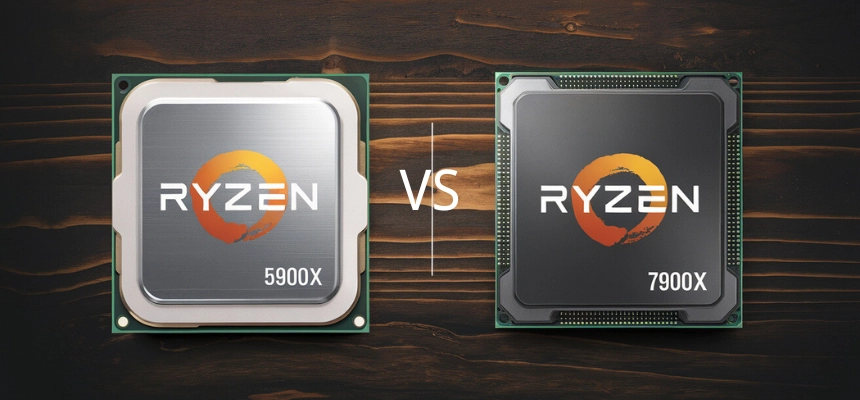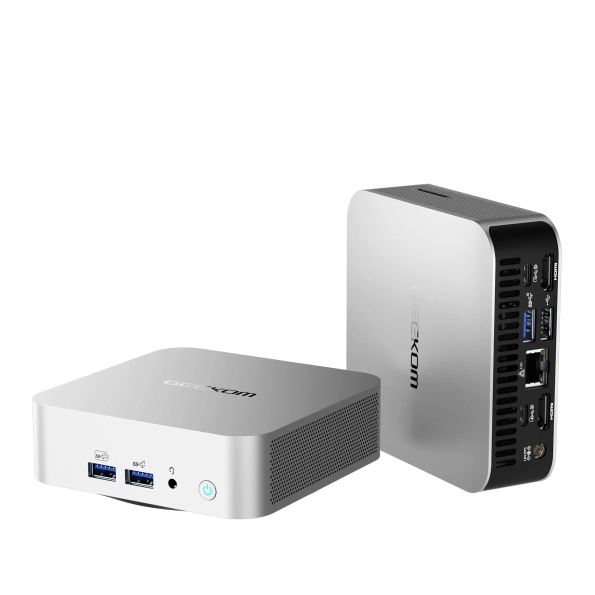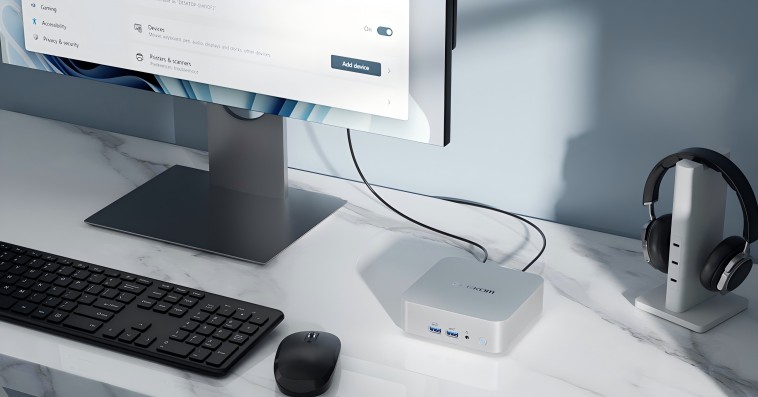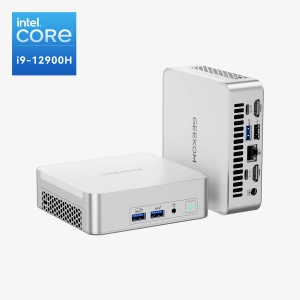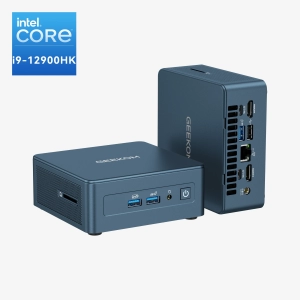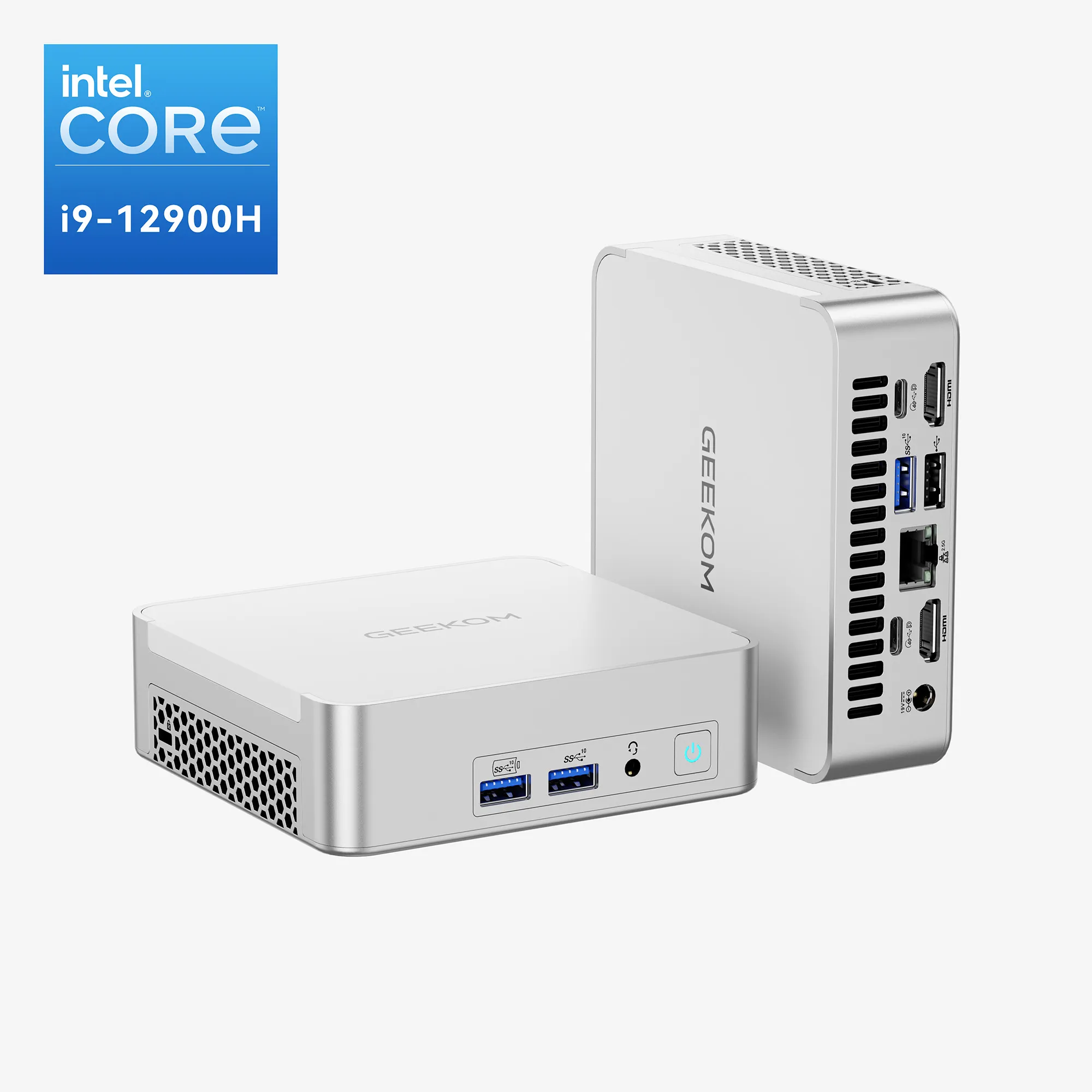Introduction
In this article, we will be comparing two of AMD’s top-tier products: the Ryzen 9 5900X and the Ryzen 9 7900X processors. Both of these desktop processors have been made with extreme performance in mind for some high-demand users, for anything from gaming to content creation. By comparing and contrasting these two processors, we will give sufficient information to help you judge how these CPUs match up concerning your computing needs.
Ryzen 9 5900X vs Ryzen 9 7900X Architecture and Technology
Depending on the workload it processes, the AMD Ryzen 9 5900X is effective on the Zen 3 architecture. Zen 3 architecture improves single-threaded and multi-threaded performance a lot, and it’s well-suitable for applications like gaming up to heavy-computation applications. It addresses the core-to-core communication and IPC efficiency within the smaller process node for a boost performance-wise while ensuring further energy efficiency enhancement.
Now, going to the Ryzen 9 7900X, we cannot overlook the very important architectural leap AMD has made to the Zen 4 architecture. Out goes the 7nm previous architecture, and in comes the 5nm process technology with, at standard settings, a 15% general boost in IPC performance over Zen 3. In combination with higher speeds and energy efficiency, it enhances induced performance speed while also lowering power consumption. The Zen 4 features faster DDR5 and PCIe 5.0 support, resulting in data transfer rate improvements and a broader bandwidth, thereby granting special advantages in data computing and future-proofing systems so that they can meet more demanding software requirements.
These architectural improvements over 7900X affect CPU performance and efficiency. For example, higher IPC means that with an increase in clock speed, each core can get more tasks/tasks done, shortening the time to get things done. That means more user experience enhancement, speeding up the process regarding time consumption or heavy processing at the end. Entering this new high-performance area of memory and PCIe, we will be seeing more improvements in gaming and professional development, especially regarding real-time data input and fast-moving calculations. With this extremely favourable combination of memory support and a lot of throughput improvement, the Ryzen 9 7900X is shaping up to be a forthright contender for modern and future computing demands.
Ryzen 9 5900X vs Ryzen 9 7900X Specs
The table below outlines the key specifications of the AMD Ryzen 9 5900X and Ryzen 9 7900X, providing a clear basis for comparison:
| Specification | Ryzen 9 5900X | Ryzen 9 7900X |
| Core Count | 12 | 12 |
| Thread Count | 24 | 24 |
| Base Clock | 3.7 GHz | 4.7 GHz |
| Boost Clock | Up to 4.8 GHz | Up to 5.6 GHz |
| Total L3 Cache | 64 MB | 64 MB |
| TDP | 105 Watts | 170 Watts |
| Supported Memory | DDR4 | DDR5 |
| PCIe Version | PCIe 4.0 | PCIe 5.0 |
The Ryzen 9 5900X and Ryzen 9 7900X closely resemble each other in core and thread counts as well as the L3 cache memory size; however, their clock speeds, TDP, and memory support considerably differ from each other, which affects user experiences in different applications.
- Clock Speeds: The base and boost clocks of the Ryzen 9 7900X are high. Thus, the speed or performance of the tasks is higher. It specifically shows in single-threaded applications, some games, and software that work faster with a few cores. Hence, the Ryzen 9 7900X sees the advantage as one best suited for use in environments where peak performance and speed start becoming necessary.
- TDP and Energy Efficiency: The Ryzen 9 7900X has a higher TDP compared to the 5900X, which suggests that the processor may be a touch less power-effective, but this also means that in cases of proper cooling, a much better performance is assured. Crucial for these users when the tasks they perform push the CPU to work rigorously for longer durations.
- Memory and PCIe Support: The Ryzen 9 7900X offers DDR5 and PCIe 5.0 support, hence enabling higher speeds along with quite a future-proofing. This will be particularly useful in scenarios that require a rapid transfer and access of the data, such as video editing, even large-scale simulations, or high-resolution gaming setups.
On the whole, the contrasting specifications of the Ryzen 9 5900X and Ryzen 9 7900X suggest that while both perform admirably in multi-threaded environments, the Ryzen 9 7900X does have an edge in speed, future-proofing, and perhaps handling more challenging tasks in a generally efficient manner.
Performance Comparison: Which Is Better?
To firm up an unbiased data analysis of AMD Ryzen 9 5900X and Ryzen 9 7900X performance divergence, we’ll evaluate their capability in diverse benchmarks. The below tables are the epitome of single-thread and multi-thread performance scores, together with gaming FPS data at separate resolutions.
Single-Thread Performance
| Benchmark Tool | Ryzen 9 5900X Score | Ryzen 9 7900X Score |
| Cinebench R23 Single | 1510 | 1930 |
| Geekbench 5 Single | 1680 | 2100 |
Single-threaded performance is crucial for such applications as gaming and continuous use of specific software operations and such performance favors the single-thread. With the Ryzen 9 7900X, single-threaded tasks have exhibited a clear advantage. Higher scores are reflected in both Cinebench R23 and Geekbench 5 for Ryzen 9 7900X, which augur well for it when it comes to web browsing, office productivity applications, and older games that depend heavily on single-core efficiency.
Multi-Thread Performance
| Benchmark Tool | Ryzen 9 5900X Score | Ryzen 9 7900X Score |
| Cinebench R23 Multi | 22100 | 27500 |
| Geekbench 5 Multi | 14000 | 17500 |
In the multi-threaded arena, which draws an advantage from having more cores and threads, once again we find the Ryzen 9 7900X comfortably in front of the Ryzen 9 5900X. There is enough proof from the Cinebench R23 and Geekbench 5 Multi scores to assert that the 7900X is, indeed, superior in rendering demanding applications such as video editing, 3D modelling, and compiling programs.
Productivity Tasks
Be it Adobe Premiere, Photoshop, or multitasking in Microsoft Office or Windows, the architectural improvements in Ryzen 9 7900X let it process tasks faster and multitask better than even its immediate forefather 5900X: 20 per cent faster in rendering a project under Premiere.
Ryzen 9 5900X vs Ryzen 9 7900X Gaming Performance
Here is a comparison of the average frame rates that each CPU can achieve in several popular games, tested at various resolutions with high graphical settings using an NVIDIA GeForce RTX 3060 Ti:
| Game | Resolution | Ryzen 9 5900X FPS | Ryzen 9 7900X FPS |
| Cyberpunk 2077 | 1080p | 112 | 130 |
| The Witcher 3 | 1440p | 144 | 165 |
| Fortnite | 1080p | 240 | 270 |
In favour of the Ryzen 9 7900X, gaming uses more FPS in almost every new modern-day gaming across different resolutions, making it, when playing graphics-intensive games like Cyberpunk 2077 and The Witcher 3, a big chance for gamers to improve their clock speed and increment their IPC and play with a lesser degree of lag.
The data points point to a wider gap confirming the Ryzen 9 7900X-rights: newer architecture, higher performance metrics-it essentially proves better performance than the Ryzen 9 5900X both in specialized and in some general computing tasks.
Power Consumption and Thermal Management
Power Consumption
The Ryzen 9 5900X, thanks to its TDP of 105 watts, is conceived as the ideal between performance and energy efficiency while consuming lesser power during regular workloads compared to the Ryzen 9 7900X, which has a TDP of 170 watts. Here, this is best illustrated during peak load conditions, where the bigger performance potential of the 7900X calls for more power requirements. The additional power requirement, however, for the 7900X is a reasonable concession for the massive performance increases, especially in CPU-based tasks, presenting a trade-off between more power consumption vs. higher capability any time the computer is employed for processing tasks.
Thermal Performance
Cooler thermals make the Ryzen 9 5900X one of the better processors on the lower end of the TDP spectrum. It is generally able to maintain relatively low temperatures under a variety of usage scenarios within safe operational limits without too high a complexity in air cooling. The Ryzen 9 7900X, with its higher TDP and performance, mechanically results in heating. That heat, under the various workloads, demands more active strategies for cooling. It will reach higher temperatures at load, which pushes the limits of standard enthusiast cooling solutions, especially during more protracted stretches of intense computing.
Cooling Solutions
Between the Ryzen 9 5900X and the 7900X, the latter cooler should the provision of a liquid cooling that delivers great performance within just a single high-end AIO liquid cooler installation. While the 5900X just needs some sophisticated air cooling or a medium-end AIO, the 7900X is where one is left with challenges if liquid cooling is not adopted. In any case, these cooling solutions must ease thermal efficiency while preventing thermal throttling and reaching peak performance.
Buying Guide
When to Choose Ryzen 9 5900X: Best suited for purse-string tight users who wish to have robust performance across various tasks. It is perfect for simple day-to-day computing, light gaming, and regular office work, thus offering excellent value for money. With backward compatibility with older cheaper motherboards and RAM, it becomes a feasible option for the wallet-friendly construction or update of a PC.
When to Choose Ryzen 9 7900X: Ideal for users striving for premium performance for extreme gaming, content creation, and multitasking. Indeed, the Ryzen 9 7900X inhales glory as regards technology and speed in scenarios that enforce these factors. An important advantage of this processor is that it is future-proof since it comes with DDR5 memory and PCIe 5.0, making it worth the investment for those who want to have their systems on the cutting edge of technology for years to come.
Recommend Product
AMD Ryzen 9 series is already the leader among all CPU products. GEEKOM is also a mini PC company that pursues high-end CPUs. If you are interested in minicomputers, you can undoubtedly choose them:
★★★★★ ( 4.9 Based on 42 reviews)
- AMD Ryzen™ 9 8945HS or Ryzen™ 7 8845HS.
- AMD Radeon™ Graphics 780M.
- Dual-channel DDR5 5600MT/s, up to 64GB.
- M.2 2280 PCIe 4.0 ×4 SSD, up to 2TB.
- 2.5G Ethernet, Wi-Fi 6E and Bluetooth® 5.2.
Conclusion
With this analysis, the AMD Ryzen 9 5900X and Ryzen 9 7900X are compared concerning their single-thread and multi-thread capability performance, gaming performance, power performance, and thermal performance. The Ryzen 9 5900X does present a good performance yet is conservative in price for basic computing, brief gaming, and regular productivity. The processor was made for users who want reliable performance without spending too much.
On the other hand, the Ryzen 9 7900X was particularly marked for its massive edge when it came to high-demand scenarios like intensive gaming, content creation, and data-heavy applications; add to that the fact that it also supports DDR5 memory and PCIe 5.0 and, voilà, it becomes the more future-proof choice-a choice directed at tech enthusiasts and professional users who need the best performance and are willing to embrace more innovative cooling solutions and top-notch memory technologies.
Looking into the future, we’ll see another trend for CPU technology toward increased efficiency, greater core counts, and stronger incorporation of AI and machine learning capabilities. Such trends suggest that future processors will be not merely faster but smarter: capable of more dynamic adjustment to user requirements. Users planning to upgrade or build a new system should compare the Ryzen 9 5900X and Ryzen 9 7900X, keeping in mind both current demands and imminent advances in CPU technology.





